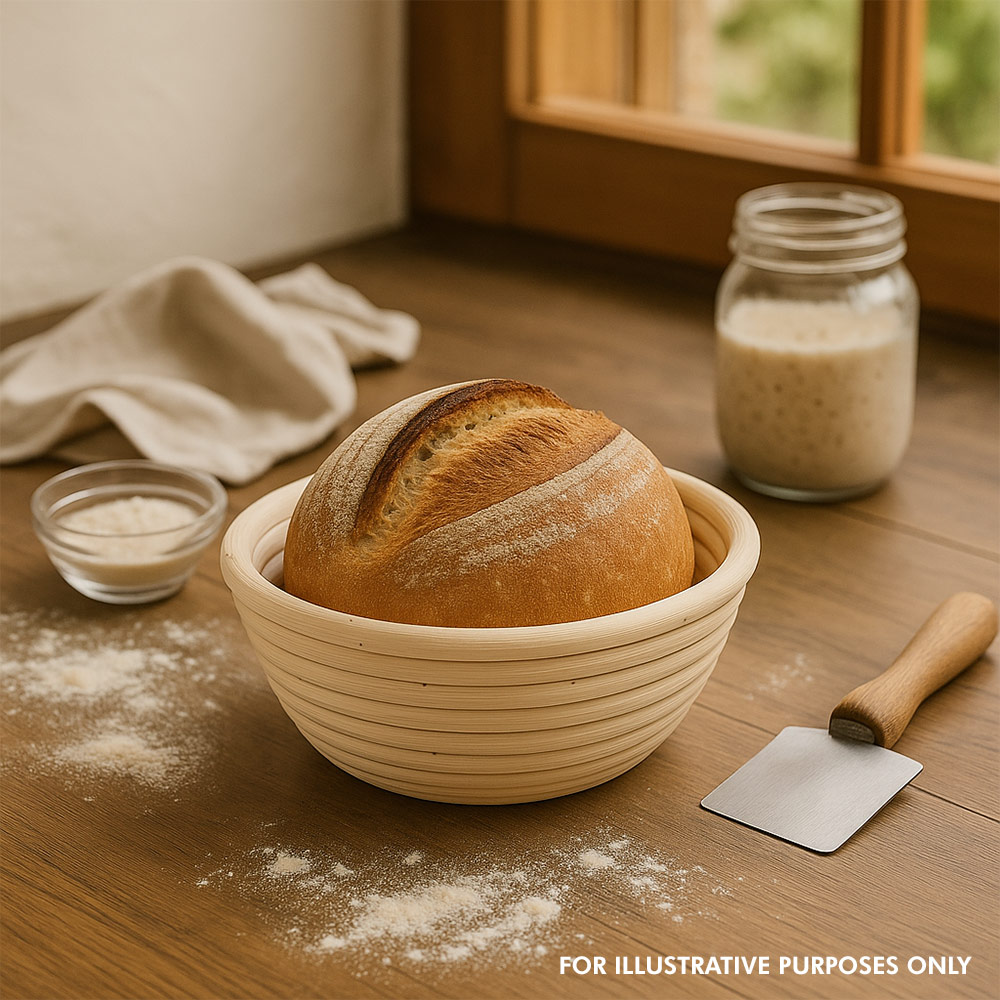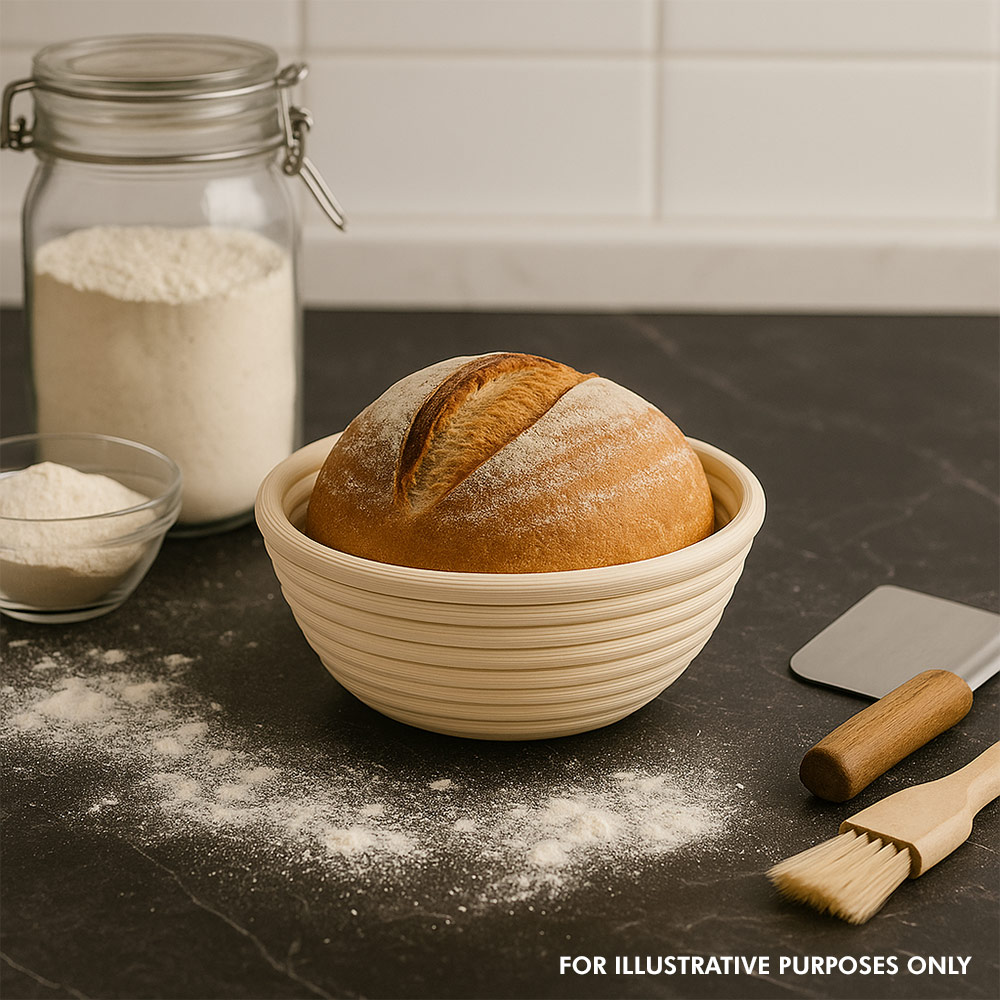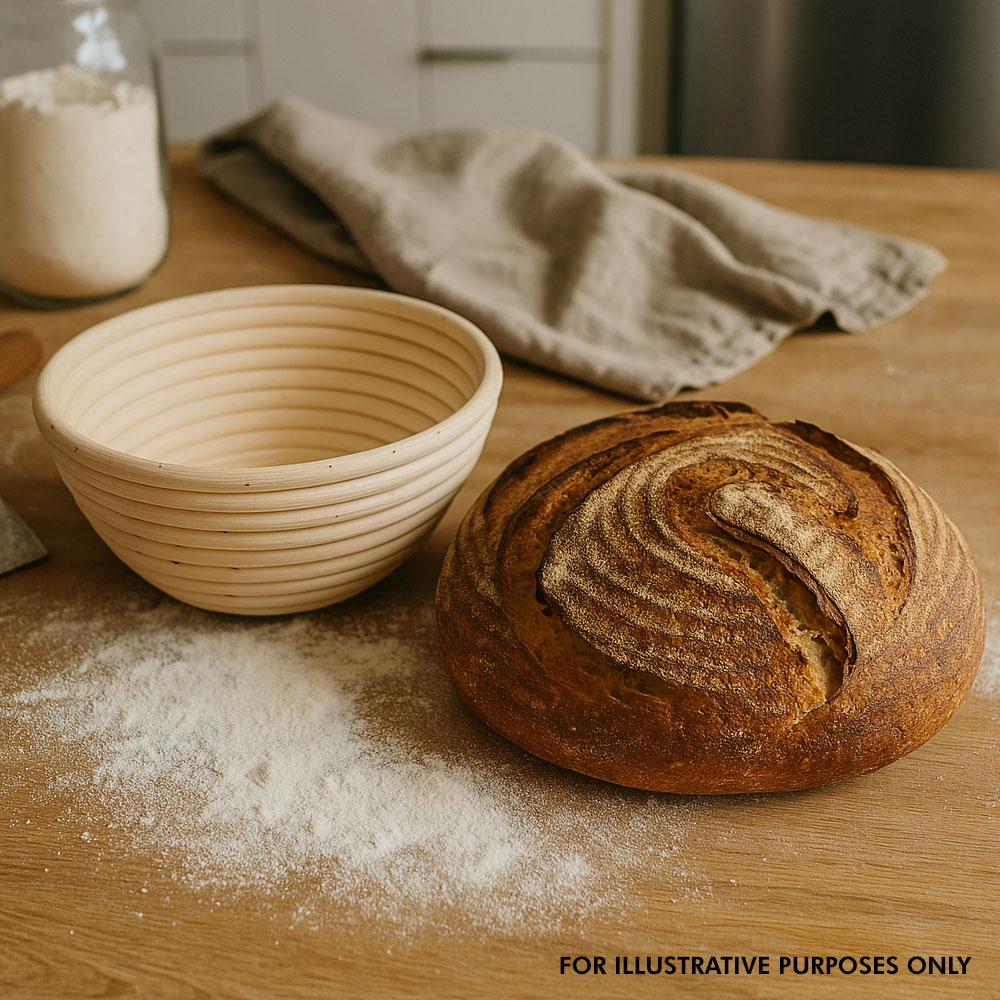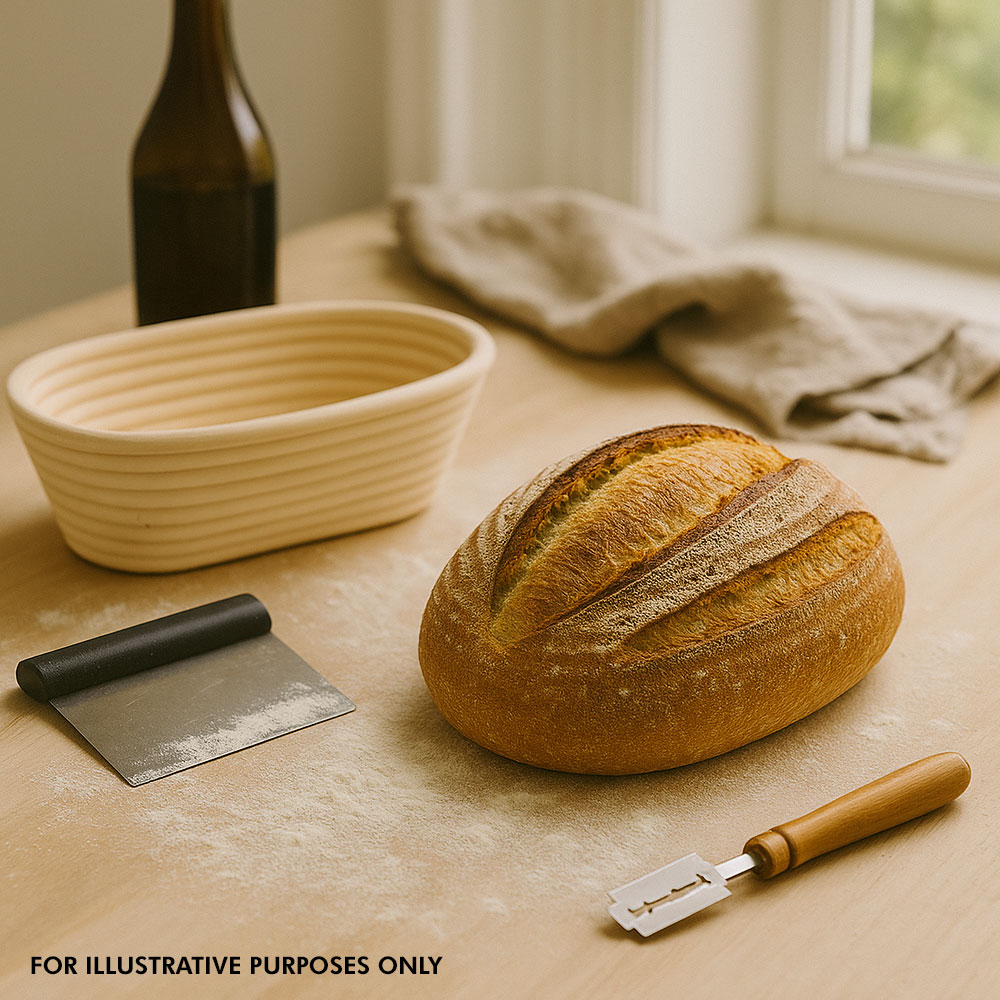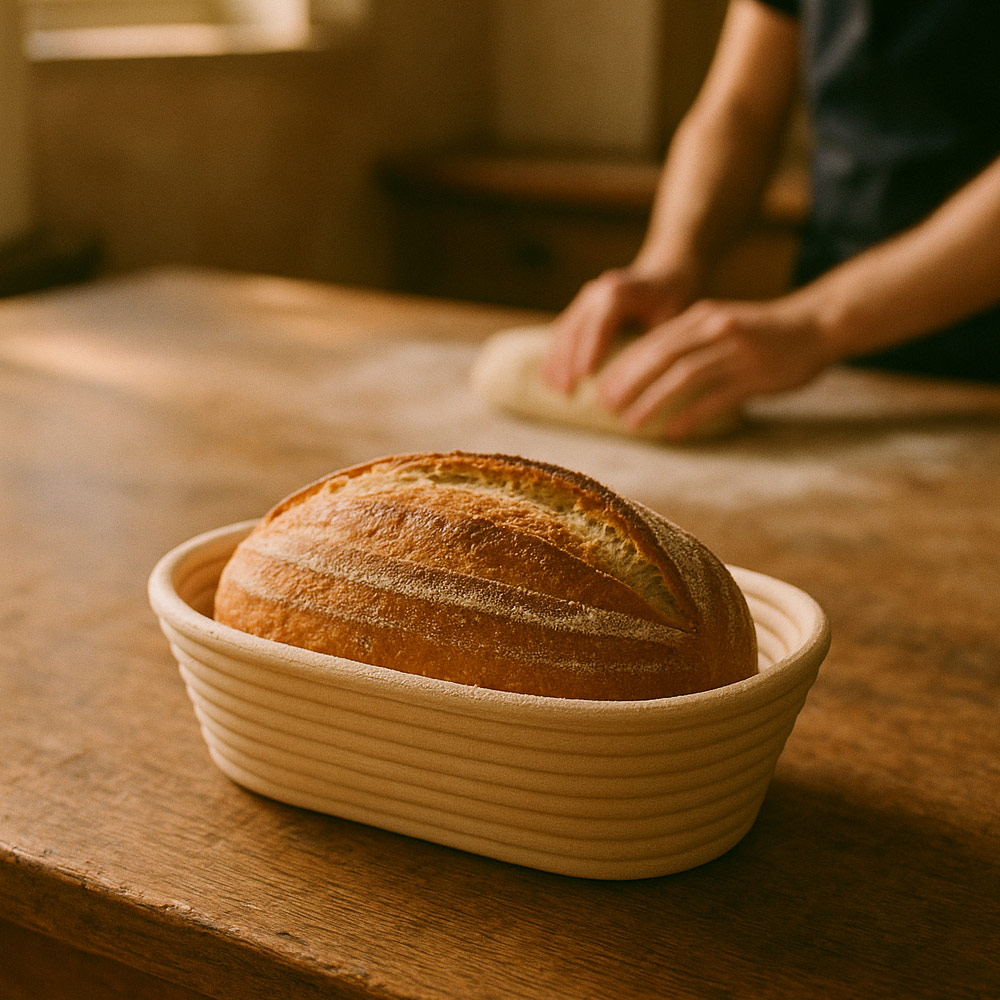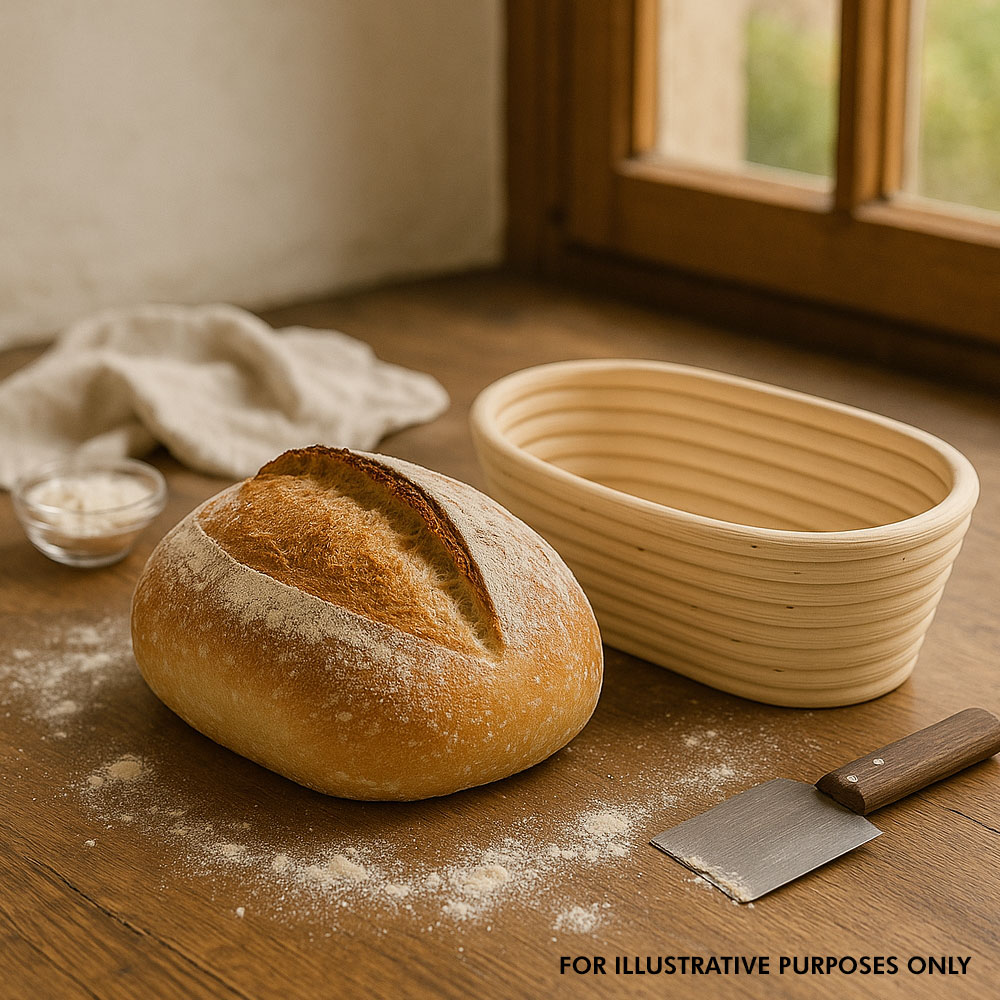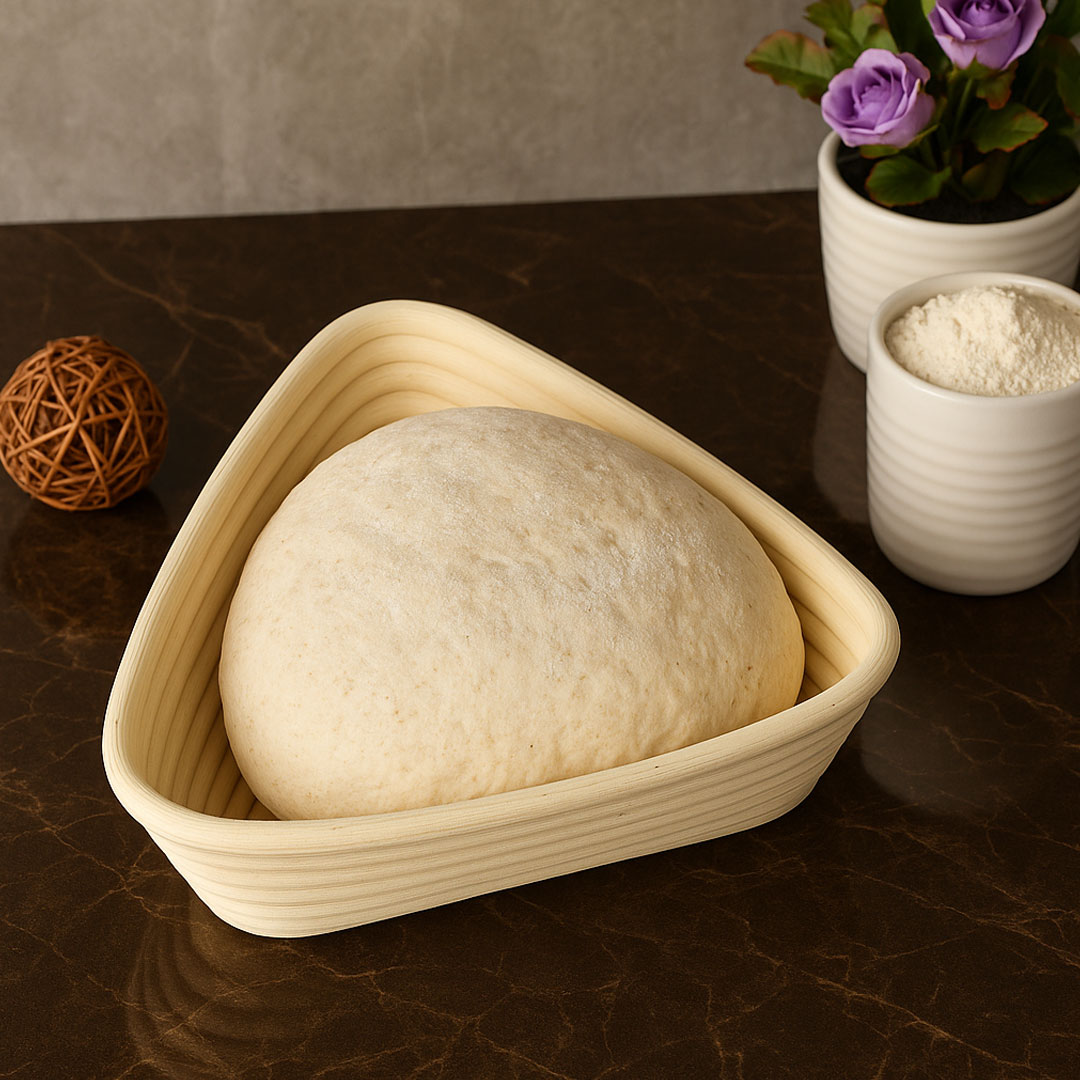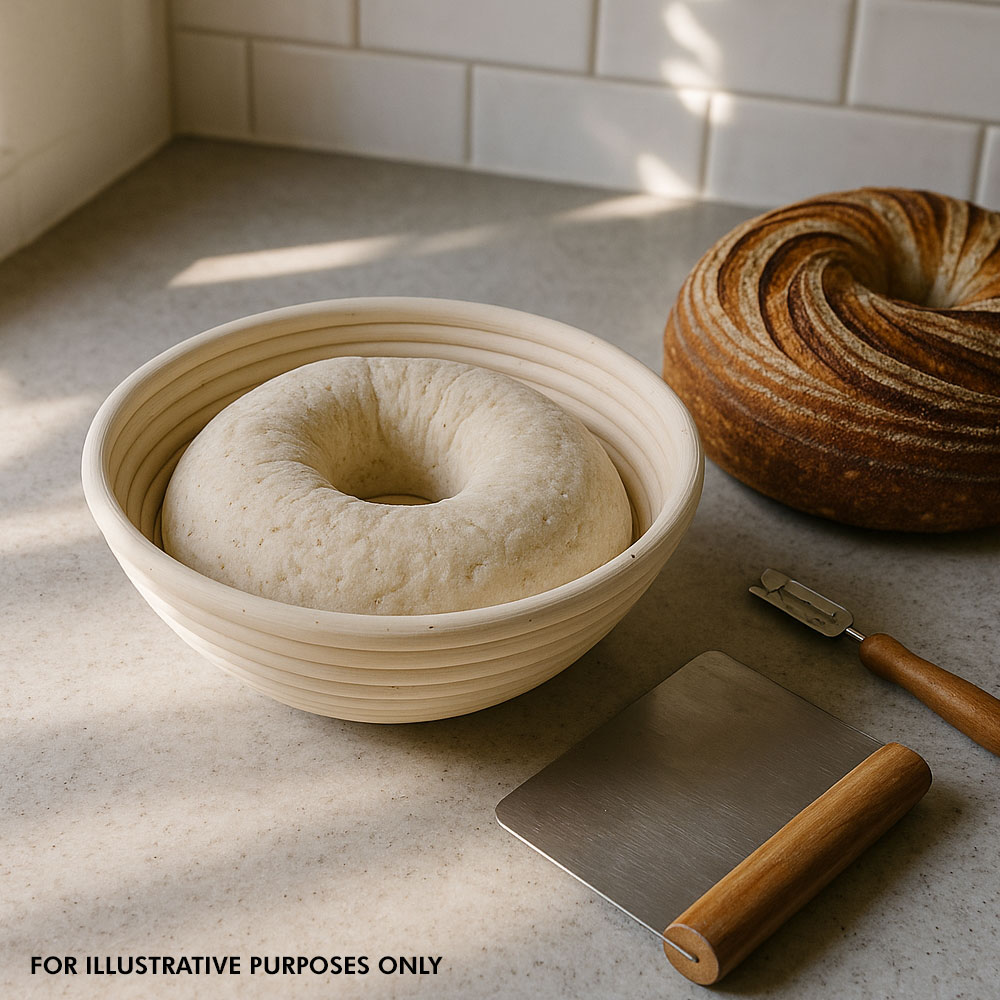Banneton Basket for Sourdough
17-07-2025
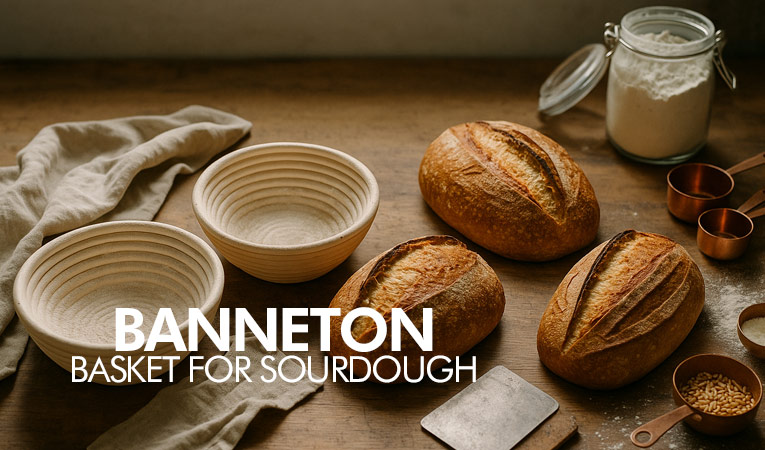
Artisan bread baking is no longer confined to professional bakeries. With the rise of home bakers exploring naturally leavened loaves, sourdough baking has become a cherished ritual. The soul of a good sourdough is not just in the starter or the flour. It is in the fermentation, the shaping, and how the dough is nurtured during proofing. That is where a Banneton basket for sourdough plays a crucial role. This simple yet essential tool gives structure to your dough, helping it rise into beautifully domed boules and batards with distinct crust patterns and rustic charm.
Made from natural materials like rattan or cane, a Banneton basket for sourdough supports the final rise by allowing the dough to breathe. This process results in a delicate skin on the dough surface, giving it strength to hold its shape. The spiral ridges of the basket leave signature artisan marks on the crust, making your loaf not only taste better but look professional too. Whether you bake once a week or every day, investing in a high-quality Banneton basket brings consistency and artistry to every loaf.
Choosing the right basket depends on the type of sourdough you bake, your experience level, and the desired bread shape. Oval baskets are ideal for longer batards or baguette-style loaves, while round Bannetons help create tight boules. Triangular options offer an unconventional silhouette perfect for experimental bakers. Using the correct size and shape ensures your dough proves evenly without spreading, collapsing, or cracking during baking. With just a bit of flour and care, a Banneton can become your most trusted baking companion.
In this blog, you will discover the true value of a Banneton basket for sourdough baking. From choosing the right one to using and caring for it, we will cover everything you need to make your bread rise to its full potential. You will also find product recommendations and answers to common proofing questions, making this your go-to guide on elevating your sourdough loaves.
What Is a Banneton Basket for Sourdough?
A Banneton basket for sourdough is a traditional tool used during the final proofing stage of bread making. Often referred to as a brotform or proofing basket, it is specially crafted to help sourdough maintain its shape and develop its signature crust before baking. Made primarily from natural materials such as rattan or cane, these baskets allow for gentle airflow around the dough, encouraging a thin, dry skin to form on the surface. This skin helps the dough hold its structure during scoring and oven spring, ensuring a well-defined loaf every time.
Bannetons come in various sizes and shapes to suit different bread styles and baking needs. The most common shapes include round, oval, and increasingly popular triangular forms. Round baskets are ideal for rustic boules, while oval ones suit elongated batards or sandwich-style loaves. Triangular baskets offer a visually striking option for bakers looking to experiment with shape and scoring design.
The coiled structure of a Banneton basket serves more than just an aesthetic purpose. As the dough rests inside, the basket’s ridges imprint spiral lines onto the crust, enhancing the rustic look that sourdough is known for. When used with a dusting of flour or a liner, the dough easily releases from the basket without sticking. This simple, elegant design has been relied on by traditional bakers for centuries and continues to be a favorite among sourdough enthusiasts today.
For anyone serious about sourdough baking, understanding the function and variety of a Banneton basket is the first step toward improving loaf quality and appearance. If you’re wondering how to choose the right one, explore our Banneton Basket Buying Guide, which offers detailed insights into selecting the perfect fit based on loaf type, size, and experience level.
Benefits of Using a Banneton Basket for Sourdough
Proofing sourdough without proper structure often results in flat, overextended loaves that lack uniformity. A Banneton basket for sourdough introduces a level of precision and elegance that transforms your baking experience. From shaping assistance to crust development, the advantages are both functional and aesthetic.
Here are the key benefits:
- Consistent Dough Shape: A Banneton basket provides reliable support during the final proof, helping your dough maintain its intended shape. Whether working with high-hydration dough or stiffer varieties, the basket prevents the loaf from spreading too much before baking.
- Improved Surface Texture: The spiral ridges or cloth liner in the basket imprint unique patterns onto the dough, creating a rustic finish that’s instantly recognizable as artisan sourdough. These markings not only beautify the crust but also act as natural scoring guides.
- Enhanced Crust Formation: The breathable material of the basket absorbs a small amount of surface moisture, helping form a thin skin on the dough. This results in a more pronounced oven spring and a satisfying, crunchy crust.
- Efficient Proofing: By promoting airflow and even fermentation, the Banneton basket ensures that your sourdough rises uniformly. This is especially beneficial during long cold ferments when temperature and moisture control are crucial.
- Easy Handling: Using a basket makes the transfer of proofed dough to a Dutch oven or baking stone smoother. With proper flouring, the dough easily releases from the basket without tearing or deflating, preserving all the volume you worked hard to build.
- Professional Presentation: The finished loaf looks bakery-quality, complete with well-defined scoring and a rounded, structured body. For home bakers aiming for Instagram-worthy results or a polished look at farmer’s markets, a Banneton delivers visual appeal.
These benefits make it clear that a Banneton basket for sourdough is not just an accessory, but a valuable tool in perfecting both the process and the final outcome. Incorporating one into your routine can elevate your baking and bring more consistency to each loaf.
How to Use a Banneton Basket for Sourdough?
Using a Banneton basket for sourdough is a simple yet essential step in achieving beautifully shaped loaves with a crisp, well-developed crust. While the basket may seem like a humble tool, its role in final proofing can significantly influence the success of your sourdough bake. Mastering its use involves a few key steps, from flouring the basket correctly to transferring the dough with care. This process can become second nature with a little practice and attention to detail.
To begin, ensure your Banneton is clean and dry. If it is a new basket, lightly mist it with water and dust it with a generous amount of rice flour or a blend of all-purpose and rice flour. Rice flour is less likely to absorb moisture from the dough, helping to prevent sticking. This flour coating acts as a non-stick layer and allows the dough to retain the intricate spiral or cloth pattern of the basket. Many bakers also choose to use a removable liner, which can be floured and washed easily for convenience.
After shaping your sourdough into a boule or batard, gently place it seam side up in the basket. The seam side faces up because the dough will be flipped out before baking, making the smoother side the top of your finished loaf. Cover the basket with a breathable cloth or a food-safe plastic wrap to prevent drying out. Let the dough proof at room temperature or place it in the refrigerator for a longer, cold ferment. The basket helps the dough maintain its shape during this final rise while encouraging even fermentation.
When ready to bake, carefully invert the basket onto parchment paper or a peel. The dough should release easily if the basket was properly floured. Score the top with a lame or sharp blade to control how the loaf expands in the oven. Quickly transfer it into your preheated Dutch oven or onto a hot baking stone for the best oven spring. With the support of a Banneton basket for sourdough, your bread will emerge with defined lines, improved rise, and a signature artisan look.
To explore more details about the process, including shaping tips and proofing temperatures, visit our step-by-step guide on How to Use Bread Proofing Basket. This resource helps fine-tune your approach to proofing and enhances your confidence with every loaf.
Caring for and Maintaining Your Banneton Basket
A well-maintained Banneton basket for sourdough can last for years, supporting countless loaves with consistent performance. Because these baskets are made of natural materials like rattan or cane, they benefit from careful handling and proper storage. Unlike metal or plastic tools, Bannetons are sensitive to excess moisture, improper cleaning, and enclosed storage conditions. Preserving their structure, cleanliness, and airflow is key to achieving the same level of quality bake after bake. Whether you use it daily or occasionally, the following care practices will help extend the life of your basket while ensuring each loaf proofs in a clean, safe environment.
Here are essential care tips to follow after each use:
- Remove excess flour and dough using a dry brush. A stiff-bristled brush helps keep the interior clean without damaging the surface texture. Avoid washing the basket after every use unless absolutely necessary.
- Allow any stuck dough to dry fully before brushing it off. Dry dough flakes off easily and avoids fiber damage, while wet cleaning can weaken the rattan over time.
- Do not soak the basket in water. A quick rinse is acceptable if required, but always ensure the basket is thoroughly air-dried afterward to prevent mold.
- Dry the basket in a warm oven (switched off) or a well-ventilated area. Even low residual heat is effective for drying out hidden moisture and extending the basket's lifespan.
- Disinfect occasionally using dry heat. If any odors or mold spots develop, heat the empty basket in an oven for 10–15 minutes at low temperature to eliminate bacteria.
- Avoid enclosed or humid storage spaces. Always store your Banneton in a dry area, preferably upright on an open shelf or hung on a wall for ventilation.
By practicing these simple habits, your Banneton basket for sourdough will remain in top condition, offering clean, consistent support to your dough every time. Regular brushing and careful drying prevent the growth of mold and preserve the basket’s coiled structure, which is essential for maintaining its aesthetic and functional qualities. If you need more detailed advice on cleaning or preparing your basket before first use, refer to our complete guide on How to Prepare & Care for your Banneton Basket. A little attention goes a long way in protecting your investment and ensuring your loaves always rise to the occasion.
Different Sizes and Shapes for Different Loaves
Selecting the right Banneton basket for sourdough is more than just a stylistic decision. The size and shape of the basket directly influence how your dough proofs, rises, and ultimately bakes. A well-matched basket ensures the dough holds its structure during fermentation and avoids unnecessary spreading or collapsing. Whether you’re making a classic round boule, a long batard, or an experimental shape, choosing the right Banneton helps you control the outcome and supports the texture, height, and scoring of your bread.
Understanding the characteristics of different shapes and sizes can make your sourdough baking more intentional and consistent:
- Round Bannetons are ideal for making boules, which are round, rustic loaves. These baskets help create symmetrical domes and are easy to work with, especially for beginners. They are great for traditional sourdough styles that rise upward with even crust development.
- Oval Bannetons work best for batards or sandwich-style loaves. They encourage horizontal rise, making the finished bread easier to slice and store. This shape suits higher hydration doughs as the elongated form supports gentle spread without flattening.
- Triangular Bannetons provide a modern twist and unique visual presentation. They are especially popular among artisan bakers who enjoy experimenting with creative scoring patterns. This shape can also enhance crust distribution by offering more edge area.
- Large Bannetons (e.g., 39 cm oval) are excellent for longer loaves like sourdough baguettes or when preparing dough for sharing loaves. These support extended fermentation and are ideal for bakers who scale up their recipes or bake for small gatherings.
- Smaller Bannetons (15–18 cm) are suitable for individual loaves or testing recipes. They proof smaller quantities of dough efficiently and are helpful when baking in small ovens or in warm climates where dough tends to expand quickly.
Choosing the proper size is just as crucial as the shape. A basket that is too large will allow the dough to flatten and lose its structure, while one that is too small may restrict rise and deform the loaf. Always match your dough weight to the appropriate basket size for optimal results. As you grow in your baking journey, having a few sizes and shapes in your collection can add variety and versatility to your loaves.
Each Banneton basket for sourdough serves a distinct purpose, helping you bring out the best in your dough based on its hydration, formula, and baking goal. Exploring different formats not only enhances your skill but also elevates the presentation of every loaf you create.
Top Banneton Basket for Sourdough Picks
Explore our curated collection of premium Banneton baskets for sourdough. Each product offers quality craftsmanship, perfect for shaping rustic boules, elongated batards, or artistic artisan loaves with professional results.
-
15 cms Round Banneton Basket
This compact basket is ideal for personal-sized loaves and small-batch baking. With a snug 15 cm diameter, it supports doughs under 500 grams and promotes a domed shape with excellent crust structure. The rattan coils naturally wick away moisture for even proofing. A perfect choice for new bakers or compact ovens. A must-have Banneton basket for sourdough starters and single-serving boules.
-
18 cms Round Banneton Basket
Made from natural rattan, this 18 cm round basket suits dough weights between 500–700 grams. The coiled walls support even fermentation while adding a rustic spiral design to the crust. Its compact size is perfect for daily baking routines and personal loaves. A great Banneton basket for sourdough enthusiasts who value balance in loaf size and crust appearance.
-
20 cms Round Bread Proofing Basket
This versatile basket is designed for classic sourdough boules weighing 700–900 grams. The 20 cm diameter helps retain moisture while forming a well-defined round shape with airy crumb structure. Crafted for consistent home baking results, it is a reliable Banneton basket for sourdough bakers aiming for uniform rise and natural crust patterns.
-
20 cms Oval Banneton Proofing Basket
This oval basket supports 700-gram doughs shaped into batards. Its elongated profile helps guide dough outward for traditional sandwich-style loaves. The breathable rattan enhances crust texture while holding shape during final rise. It is a dependable Banneton basket for sourdough loaves that require horizontal expansion and artisan scoring detail.
-
22 cms Oval Banneton Proofing Basket
This 22 cm oval basket is a top choice for medium-large batards. Ideal for 800–1000 gram doughs, it supports extended fermentation and encourages even rise. The natural material helps absorb surface moisture for a well-developed crust. A perfect Banneton basket for sourdough bakers looking to scale up production while preserving artisan quality.
-
25 cms Oval Bread Proofing Basket 6pcs
Designed for serious bakers, this value pack includes six 25 cm oval baskets ideal for bakery setups or batch baking. Each basket holds up to 1000 grams of dough, offering professional-level support for consistent batards. Made of durable rattan for long-term use. A practical Banneton basket for sourdough baking at scale or for gift sets.
-
Triangular Banneton Proofing Basket
This innovative triangular basket brings geometric flair to artisan baking. Perfect for creative scoring and bold presentation, it suits dough weights between 600–800 grams. The unique angles offer extra crust edge for crunch lovers. An excellent Banneton basket for sourdough bakers who enjoy experimenting with non-traditional loaf forms and bold shapes.
-
Bundt Rattan Proofing Basket
Inspired by the iconic Bundt cake shape, this artistic basket creates a beautifully ridged loaf with a central core. Great for festive sourdough bakes or filled savory breads, it can hold up to 800 grams of dough. A creative Banneton basket for sourdough bakers who enjoy standout presentation and impressive crust shaping.
Troubleshooting Common Sourdough Proofing Issues
Baking sourdough is an art that blends science with intuition, and even seasoned bakers occasionally encounter issues during the proofing stage. Recognizing and addressing these proofing problems can save your bake and help you grow as a sourdough enthusiast. A well-maintained Banneton, paired with proper fermentation techniques, allows the dough to rise with strength, structure, and flavor. However, when something goes wrong, knowing how to troubleshoot it can make the difference between a flat, gummy loaf and a perfectly domed artisan sourdough.
Common proofing challenges and solutions include the following:
- Dough sticking to the basket
This typically results from insufficient flouring or overly wet dough. Use a fine dusting of rice flour or a blend of rice and all-purpose flour, which offers a drier coating and prevents the dough from clinging to the basket walls. Avoid using plain wheat flour alone, as it tends to absorb moisture and leads to sticking. - Loaves losing shape or spreading too wide
Overproofing or high hydration doughs can lose structure if the gluten network is weak. Ensure proper dough strength through adequate kneading and shaping. Chill the dough before baking to firm it up and support its rise in the oven. A cold final proof also allows more defined scoring. - Lopsided or uneven expansion during baking
This often indicates inconsistent shaping or placing dough loosely in the basket. Create a tight surface tension while shaping and seal the seam properly before placing it seam-side up. The dough should fit snugly inside the proofing basket to encourage balanced rising. - Underproofed dough producing dense loaves
If the crust bursts unexpectedly or the crumb is gummy, your dough may have fermented too little. Check readiness using the finger-poke test. Gently press the surface; if the indentation springs back too quickly, the dough needs more time to rise. - Overproofed dough with weak oven spring
Overproofing causes the dough to exhaust its fermentation potential. The loaf may feel slack, spread out too much, or turn pale during baking. Reduce room temperature proofing times and shift to cold proofing methods when needed.
Using a Banneton basket for sourdough improves dough structure during proofing, but it works best when combined with attention to dough strength, fermentation timing, and shaping techniques. These small adjustments lead to a more reliable baking experience and a loaf that is not only flavorful but also a visual delight. With every bake, troubleshooting becomes easier and success more consistent.
Tips to Get the Most Out of Your Banneton Basket
Maximizing the performance of your proofing basket starts with understanding how to integrate it into your baking routine with care and consistency. A Banneton is more than a container for shaped dough. It helps define the final appearance, structure, and crust texture of your sourdough loaf. Proper use and preparation will not only improve each bake but also extend the life of the basket and ensure ease of use over time. Whether you are new to baking or fine-tuning your technique, these practical tips will help you get the best results.
Apply the following techniques to enhance your proofing experience:
- Flour generously using a rice flour blend
Rice flour resists absorption and prevents the dough from sticking to the basket surface. You can also blend it with all-purpose flour for a smoother crust finish. Always flour both the liner and basket ridges if using without a cloth. - Cold-proof the dough for added structure
Refrigeration helps firm up shaped dough, making it easier to unmold and score before baking. Cold proofing enhances flavor and supports a more pronounced oven spring, especially with high-hydration recipes. - Shape the dough with tension before placing in the basket
Creating a tight outer skin through proper shaping allows the dough to hold its form and rise upward rather than spreading. Place the dough seam-side up so the smooth surface is presented on top when flipped. - Dry your basket completely between uses
After baking, allow your basket to air dry thoroughly or place it in a warm oven with the door open. Never store it damp or in sealed containers, as this leads to mold or deterioration of the rattan fibers. - Rotate between different basket shapes and sizes
Owning multiple baskets lets you explore a variety of loaf forms and accommodate different batch sizes. Switching between round, oval, and specialty shapes can inspire creativity and improve scoring techniques. - Avoid washing unless necessary
Bannetons function best when kept dry. Use a stiff brush to remove flour or dough residue after each use. Only rinse with water if there is visible build-up, and always dry completely before storing. - Use the basket as a visual scoring guide
The natural coils of the basket leave patterns on the dough, which can guide you in scoring symmetrical or decorative cuts before baking. These natural spirals become part of your loaf’s rustic identity.
Following these simple but effective tips allows your Banneton basket for sourdough to support consistent results with every bake. As you develop your sourdough skills, proper use of your basket will play a central role in producing loaves with impressive structure, flavor, and presentation. With regular care and thoughtful technique, your Banneton becomes a dependable partner in crafting bakery-quality sourdough at home.
Frequently Asked Questions
Curious about using a Banneton in your sourdough journey? Here are answers to the most common queries from both beginners and experienced bakers. These tips will help you avoid mistakes and bake with confidence.
- Can I use a Banneton for wet high-hydration dough?
Yes, just dust generously with rice flour to prevent sticking. Wet dough benefits from the shape and airflow a Banneton provides during the final proofing stage. - How do I know which Banneton size is ideal?
Match the size of your Banneton to your dough weight. Small loaves up to 500 grams fit 15 to 18 cm, while larger loaves need 20 cm or more. - What if the dough sticks to the basket after proofing?
If sticking occurs, it is usually due to underflouring. Use a rice flour blend and line the basket if needed. Refrigerating the dough also makes unmolding easier. - Can I bake bread directly in a Banneton basket?
No, Bannetons are not meant for baking. They are only for proofing. Always invert the dough onto parchment or a baking surface before placing it in the oven. - How should I clean my Banneton after use?
Let the basket dry completely and use a stiff brush to remove excess flour or residue. Avoid washing with water unless absolutely necessary, and never store it damp. - How long does a Banneton last with proper care?
With regular dry cleaning and proper storage, your Banneton can last several years. It is a durable investment for anyone using a Banneton basket for sourdough baking regularly.
Sourdough Recipes Best Suited for Banneton Proofing
Whether you prefer classic round boules or creative shaped loaves, these sourdough recipes are perfectly suited for proofing in a Banneton. Each one brings out the best in crust, crumb, and flavor.
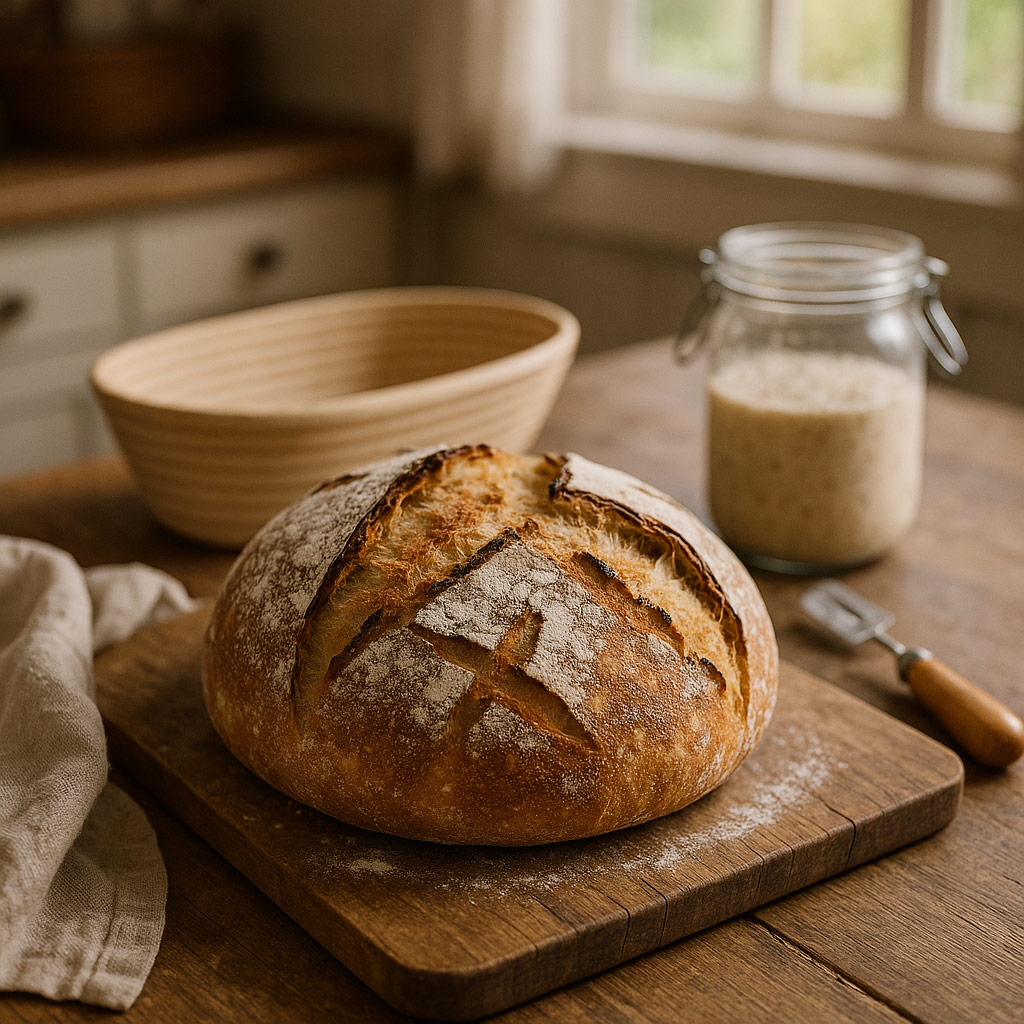
Rustic Country Sourdough
This loaf combines strong bread flour and whole wheat to create a rustic, open-crumb sourdough with a deep golden crust. Ideal for beginner to intermediate bakers. Use an 18 cms round Banneton basket for sourdough to shape the dough evenly and build structure.
Ingredients:
- 400g bread flour
- 100g whole wheat flour
- 350g water
- 100g active sourdough starter
- 10g salt
Step-by-Step Instructions:
- Mix flours and water, let rest for 30 minutes (autolyse).
- Add starter and salt, mix until combined.
- Perform three sets of stretch and folds at 30-minute intervals.
- Let dough ferment at room temperature until doubled in size.
- Shape and place into a floured Banneton seam-side up.
- Cold-proof in refrigerator for 12 to 16 hours.
- Score and bake in a preheated Dutch oven at 240°C for 20 minutes covered, then 20 minutes uncovered.
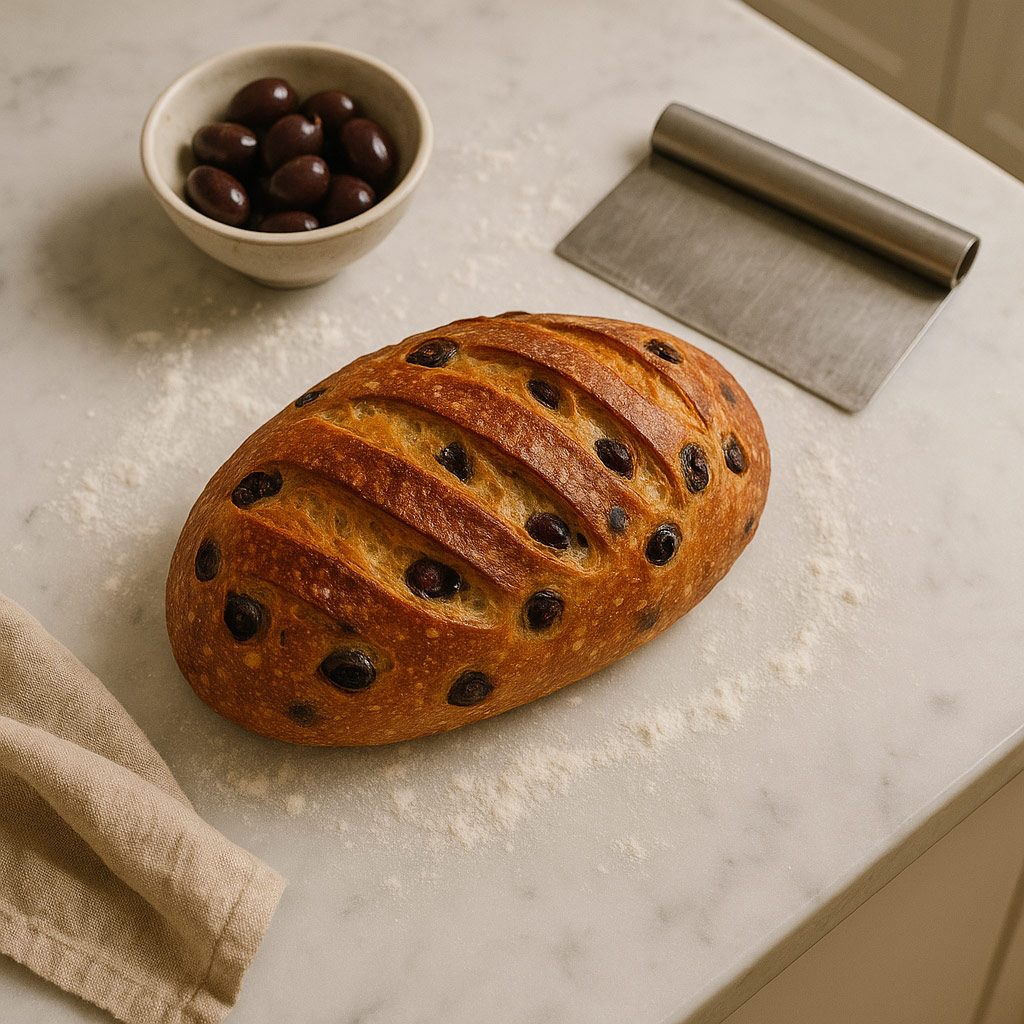
Olive Sourdough Batard
This Mediterranean-inspired sourdough features chopped Kalamata olives for a tangy twist. The batard shape pairs perfectly with an oval Banneton basket for sourdough, allowing for a horizontal rise and rich crust scoring.
Ingredients:
- 450g bread flour
- 320g water
- 100g sourdough starter
- 10g salt
- 80g chopped Kalamata olives
Step-by-Step Instructions:
- Combine flour and water, rest 30 minutes.
- Add starter and salt, then incorporate olives.
- Fold dough gently over three intervals.
- Bulk ferment for 4 to 5 hours until puffy.
- Shape into a batard and proof in an oval Banneton.
- Cold-proof overnight in the fridge.
- Bake at 230°C with steam for 25 to 30 minutes.
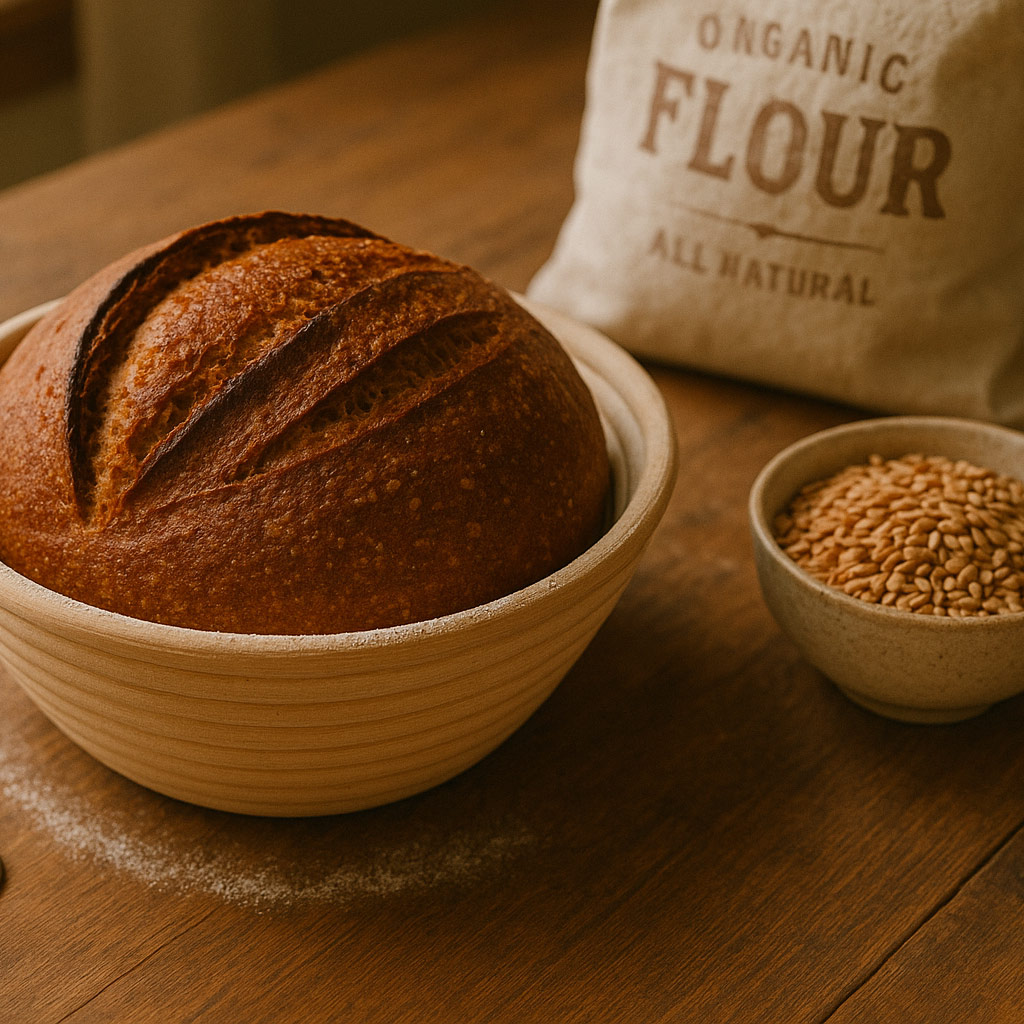
Spelt Sourdough
This recipe uses ancient spelt grain for a mildly sweet and nutty flavor. Use a 20 cms round Banneton basket for sourdough to help maintain the soft structure while encouraging a natural oven spring.
Ingredients:
- 400g spelt flour
- 300g water
- 100g sourdough starter
- 8g salt
Step-by-Step Instructions:
- Mix all ingredients until just combined.
- Let the dough rest for 45 minutes.
- Perform two stretch and folds every 30 minutes.
- Let rise until slightly puffy but not doubled.
- Shape into a round and place in Banneton.
- Proof for 1 hour at room temperature or refrigerate overnight.
- Bake at 220°C for 35 to 40 minutes.
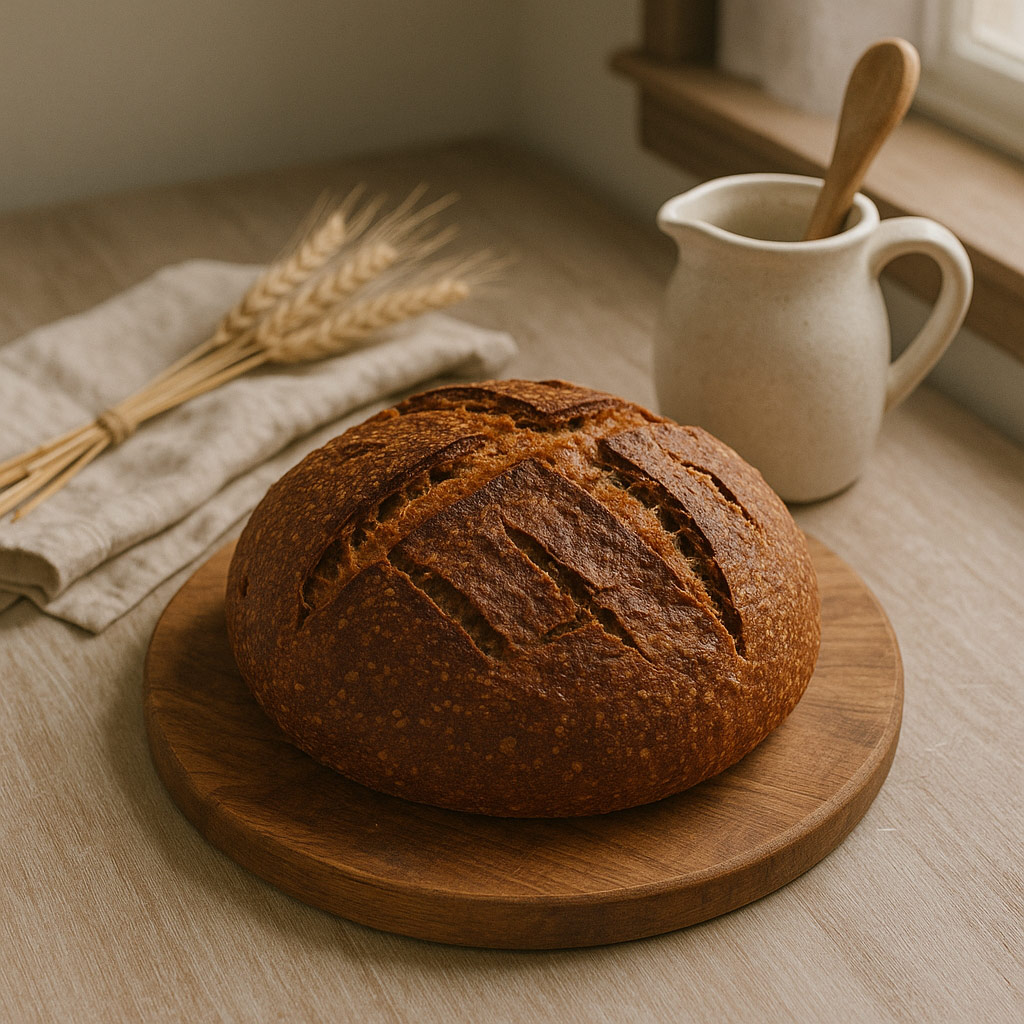
Whole Wheat Boule
Perfect for rustic meals, this whole wheat sourdough loaf delivers a hearty flavor with a moist crumb. Use a 22 cms round Banneton basket for sourdough to support its robust hydration and rounded profile.
Ingredients:
- 500g whole wheat flour
- 375g water
- 100g sourdough starter
- 10g salt
Step-by-Step Instructions:
- Mix flour and water, let rest for 1 hour.
- Add starter and salt, knead gently until combined.
- Bulk ferment for 5 to 6 hours, folding twice.
- Shape and place in floured Banneton.
- Cover and proof in the fridge overnight.
- Score and bake at 230°C for 40 minutes with steam.
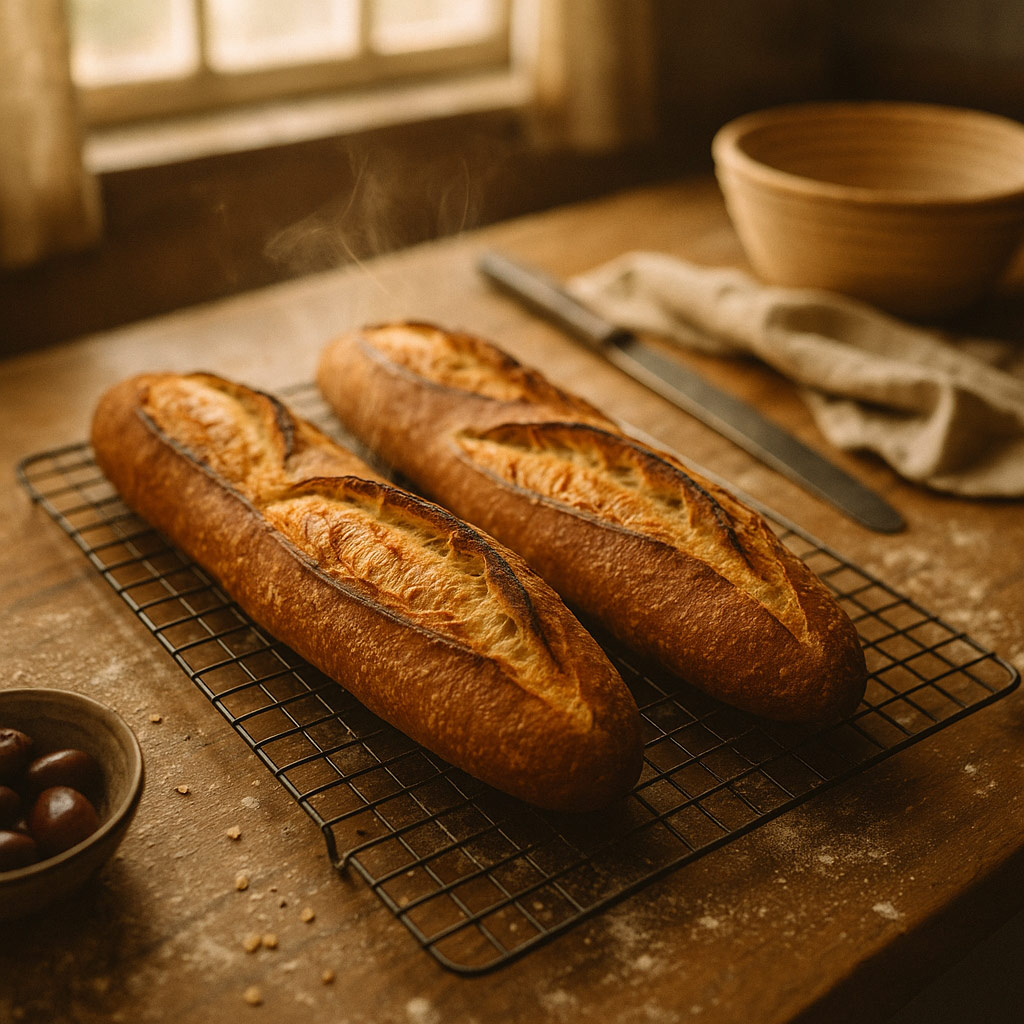
Sourdough Baguette
These long, thin sourdough baguettes feature a crisp crust and chewy interior. Use a 39 cms oval Banneton basket for sourdough to shape the dough uniformly and promote excellent horizontal rise.
Ingredients:
- 450g bread flour
- 325g water
- 100g active sourdough starter
- 10g salt
Step-by-Step Instructions:
- Mix flour and water, rest for 30 minutes.
- Add starter and salt, knead until smooth.
- Fold dough three times during bulk fermentation.
- Divide, preshape, and rest for 20 minutes.
- Shape into baguettes and place in Banneton or couche.
- Proof in the fridge for 12 hours.
- Score and bake at 240°C for 20 to 25 minutes.
Conclusion
Sourdough baking is a rewarding journey that demands patience, skill, and the right tools. Among those tools, a Banneton basket holds a vital role in shaping the final outcome of every loaf. From supporting fermentation to helping the dough retain structure during the final rise, the basket serves as a quiet partner in the sourdough process. Whether you are a beginner shaping your first boule or an advanced baker perfecting your scoring, using the correct Banneton adds consistency, texture, and visual charm to each bake.
Exploring different shapes and sizes allows you to experiment with a wide variety of loaves, from rustic batards to elegant baguettes and compact boules. Pairing your recipe with the right Banneton enhances not just proofing quality but also crust formation and crumb development. Proper care and cleaning routines ensure your basket lasts through many baking sessions, while a good understanding of fermentation helps you troubleshoot common issues. Every detail in your workflow, from flouring the basket to selecting the best recipe, adds up to create sourdough that is as beautiful as it is flavorful.
The Banneton basket for sourdough is more than a shaping tool. It is a symbol of craftsmanship and a gateway to baking with confidence. If you are ready to improve your sourdough baking, start by choosing a quality basket that suits your needs and style. Refer to the linked resources in this guide to deepen your knowledge, build your toolkit, and continue shaping loaves that rise beautifully with every bake.



